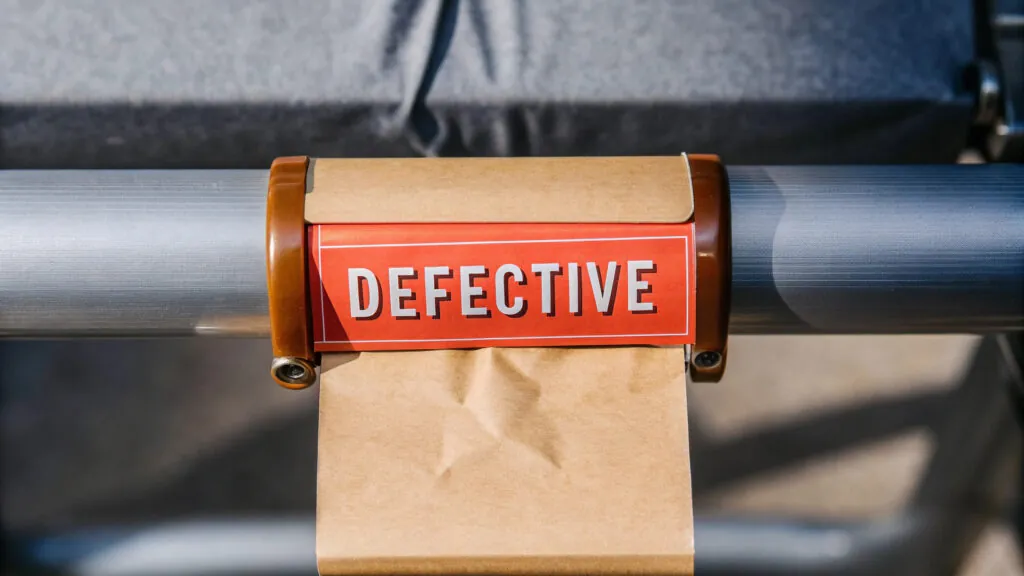Understanding product liability law in Pennsylvania is essential if you've been injured by a product or are involved in the manufacturing or distribution process. Two of the most important legal theories that arise in product-related injury cases are design defects and failure to warn.
While they are both types of strict liability claims, the elements of proof, legal tests, and case strategies differ significantly. In this guide, you’ll learn how Pennsylvania law views these claims, how courts assess them after Tincher v. Omega Flex, and what plaintiffs and defendants should know when facing these legal issues.
Pennsylvania's Legal Framework for Product Liability
What Is Strict Liability?
Strict liability in Pennsylvania allows plaintiffs to hold manufacturers and sellers responsible for defective products without proving negligence. Instead, a plaintiff must prove the product was defective and caused injury.
Role of Restatement (Second) of Torts Section 402A
For many years, Pennsylvania courts followed Section 402A of the Restatement (Second) of Torts, which imposes strict liability on sellers of defective products that are unreasonably dangerous to consumers.
Tincher v. Omega Flex: A Turning Point in PA Law
What Did Tincher Change?
In 2014, the Pennsylvania Supreme Court decided Tincher v. Omega Flex, a landmark case that reshaped the way courts evaluate product defect claims. The court rejected the rigid application of the Restatement (Third) and reaffirmed the flexible application of Section 402A.
The Two-Pronged Test Introduced by Tincher
The court in Tincher established two methods for plaintiffs to prove a product is defective in design:
- The Consumer Expectations Test, which asks whether an average consumer would find the product unreasonably dangerous.
- The Risk-Utility Test, which weighs the risks of harm against the benefits of the product’s design.
What Is a Design Defect?
Definition of Design Defect
A design defect exists when the product, although manufactured correctly, is inherently dangerous due to its design. This means every product made with that design poses the same risk.
Examples of Design Defects
Common examples of design defects might include:
- A ladder that tips over too easily due to unstable leg angles.
- A power tool without a protective guard, posing unnecessary injury risks.
- A children’s toy designed with small parts that easily detach and pose a choking hazard.
How to Prove a Design Defect Claim in Pennsylvania
Essential Legal Elements
To prove a design defect claim in Pennsylvania, the injured party must establish:
- That the product had a defective design.
- The defect was present when it left the manufacturer’s control.
- The product was used as intended or in a foreseeable manner.
- The defect caused the injury.
Choosing Between Legal Tests
Pennsylvania law allows plaintiffs to choose either the consumer expectations or risk-utility test. Selecting the right test is crucial and may depend on the nature of the product, the available evidence, and the expectations of the average consumer.
Role of Expert Testimony
Especially in risk-utility cases, expert testimony is often required to demonstrate the existence of a safer, feasible alternative design and to assess how the risks could have been mitigated.
Defenses in Design Defect Claims
Common Defense Strategies
Manufacturers facing design defect claims may assert several defenses, including:
- The product misuse defense, arguing the product was used in an unforeseeable way.
- The assumption of risk defense, suggesting the plaintiff knew and accepted the risks.
- Arguments that an alternative design was not feasible or cost-effective.
Comparative Negligence in PA
Under Pennsylvania’s comparative negligence law, damages may be reduced if the plaintiff is found partially responsible for the incident, such as using the product carelessly or contrary to provided instructions.
What Is a Failure to Warn Claim?
Inadequate Warnings as a Basis for Liability
Even when a product is properly designed and manufactured, a failure to warn claim may arise if users were not informed about potential dangers. This duty applies to known risks, foreseeable misuse, and newly discovered hazards that come to light after sale.
When Warnings Are Legally Required
A manufacturer must provide adequate warnings or instructions if:
- The product has non-obvious risks.
- The product can cause harm when misused in foreseeable ways.
- The danger could have been reduced or eliminated through a proper warning.
How Courts Evaluate Warning Adequacy
Characteristics of an Inadequate Warning
A warning is considered legally inadequate if:
- It is hidden or placed where users are unlikely to notice it.
- It uses confusing, overly technical, or vague language.
- It does not explain the severity of the risk.
- It fails to warn against foreseeable misuse.
Example Scenarios
Consider a chemical cleaning product that lacks a warning about mixing with bleach, or an electric saw that doesn’t alert the user about potential kickback. In these cases, the absence of clear warnings could support a failure to warn claim.
Special Doctrines in Pennsylvania Warning Law
The Learned Intermediary Rule
In medical and pharmaceutical cases, Pennsylvania courts apply the learned intermediary rule. This doctrine shifts the duty to warn from the manufacturer to the doctor. If the doctor was properly informed of the drug’s risks, the manufacturer may not be liable for failing to warn the patient directly.
Post-Sale Duty to Warn
Manufacturers also have a duty to issue warnings after the product has been sold if new risks are discovered. Failing to recall the product or update consumers could result in additional liability.
Comparing Design Defects and Failure to Warn
Key Differences Between the Two Claims
Although they are both part of product liability law, design defect and failure to warn claims focus on different aspects of the product’s safety:
- Design defect focuses on the inherent danger in the product’s physical structure.
- Failure to warn focuses on the absence or inadequacy of instructions or safety information.
Different Evidence Required
Design defect cases may require engineering analysis, while failure to warn cases may rely on product manuals, label design, and internal company documentation about known risks.
Legal Requirements and Causation
What Plaintiffs Must Prove
In either type of claim, plaintiffs must show:
- That the defect or inadequate warning existed.
- The product was used as intended or in a foreseeable way.
- The defect or missing warning was the proximate cause of the injury.
Burden of Proof
The burden of proof lies with the plaintiff, who must demonstrate that the manufacturer’s failure was a substantial factor in causing the harm.
Frequently Asked Questions
Can I sue a manufacturer if there was no warning label on a product?
Yes, under Pennsylvania law, you may have a valid failure to warn claim if a product lacked an appropriate warning and that omission contributed to your injury. The absence of a warning label becomes legally significant when the risk involved is not obvious to an ordinary user and when proper instructions or labels could have helped you avoid the harm. A successful claim typically requires showing that the manufacturer knew or should have known about the risk and failed to communicate it effectively.
What’s the legal difference between a design defect and a failure to warn?
A design defect refers to a fundamental flaw in the product’s actual blueprint or intended design, meaning that even when manufactured correctly, the product is still unsafe for consumer use. A failure to warn, on the other hand, deals with products that are generally safe when used properly but can become dangerous if users are not adequately warned about risks or instructed on safe use. In short, design defects involve how the product was made, while failure to warn involves what the user was (or wasn’t) told.
Is it enough to claim a product caused an injury, or do I need to prove something more?
It’s not enough to simply show that you were injured while using a product. In Pennsylvania, you must demonstrate that the injury resulted directly from a specific defect—either in the design or in the failure to provide adequate warnings—and that the defect existed when the product left the manufacturer’s control. Additionally, you need to prove that you were using the product in a reasonably foreseeable manner at the time of the injury. Causation and foreseeability are key legal components of any product liability case.
How did the Tincher v. Omega Flex decision affect product liability claims in Pennsylvania?
The Pennsylvania Supreme Court’s decision in Tincher v. Omega Flex significantly reshaped the legal landscape for product liability cases in the state. It rejected the rigid reliance on the Restatement (Third) of Torts and instead reaffirmed the broader standards found in the Restatement (Second), specifically Section 402A. The court also introduced a two-part framework—allowing plaintiffs to prove defectiveness through either the consumer expectations test or the risk-utility balancing test. This decision gave juries greater discretion in determining whether a product is unreasonably dangerous and expanded the ways plaintiffs can present their case.
Can I still win a product liability case if I used the product in a slightly different way than the instructions said?
Possibly. Pennsylvania law recognizes the concept of foreseeable misuse. This means that even if your use of the product wasn’t exactly what the manufacturer intended, you may still recover damages if your use was reasonably foreseeable. For instance, using a chair to reach a high shelf might not be the intended use, but it is foreseeable. If the product failed under such circumstances and caused injury, the manufacturer may still be held liable, especially if no warning was given about that kind of risk.
Final Takeaways for Pennsylvania Product Liability Cases
Navigating a product liability case in Pennsylvania requires a deep understanding of the law, particularly the distinctions between design defect and failure to warn theories. Each claim has its own legal elements, evidentiary requirements, and defenses.
Whether you're a consumer who suffered harm or a manufacturer facing a potential claim, understanding how Tincher v. Omega Flex and Section 402A apply is essential. In many cases, your choice of legal theory can influence the outcome of the case more than the facts themselves.
Contact Fulginiti Law Today
If you or a loved one has been injured due to a product's dangerous design or a lack of proper warning, don’t delay in seeking legal guidance. Pennsylvania law provides powerful tools for holding manufacturers accountable, but navigating them without help can be complex and risky.
Reach out to Fulginiti Law today to understand your rights, evaluate your legal options, and take the first step toward securing the compensation you deserve.



